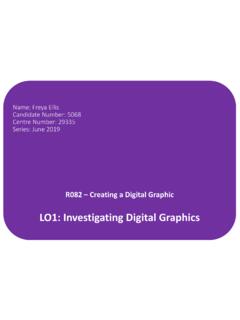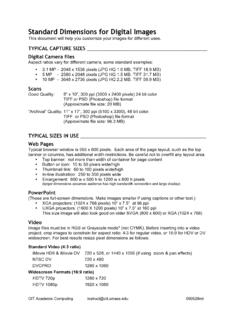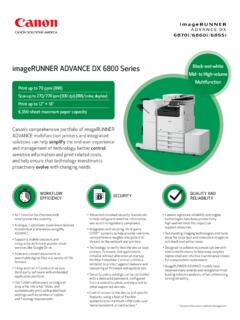Transcription of WaveDrom
1 WaveDrom Rendering Beautiful Waveforms from Plain Text Aliaksei Chapyzhenka Jonah Probell Abstract WaveDrom is a tool for rendering digital timing diagrams, and other technical visualization, as SVG or PNG images from an intuitive plain text language. It is easy to learn, easy to use, and browser-based. WaveDrom is free open source software. This paper provides simple and complex examples of code and its resulting graphics. Also provided are guidelines on integrating WaveDrom into source code, diffing waveforms, parameterizing waveforms, describing and visualizing constraints, expressing design intent, and generating assertions. SNUG 2016 Page 2 WaveDrom : Rendering Beautiful Waveforms from Plain Text Table of Contents Introduction .. 3 Problems with current practices .. 3 Inspiration .. 4 Exchange format (WaveJSON) .. 5 image rendering .. 5 Waveforms in code comments .. 8 Diffing waveforms .. 9 Parameterization .. 10 Representing constraints in WaveJSON.
2 11 Generating assertions .. 13 Other users .. 16 Conclusion .. 16 SNUG 2016 Page 3 WaveDrom : Rendering Beautiful Waveforms from Plain Text Introduction digital timing diagrams ( waveforms ) are the type of diagram that best describe how electronic signals do, or should, behave. Chip designers naturally draw waveforms on whiteboards, and routinely view waves when debugging simulations. When called upon to write a specification, we know our word processing options. However, there has never been a simple, widely used tool for rendering waveforms. That is until now. WaveDrom is a tool for rendering waveforms as SVG or PNG It defines a language that uses textual symbols, which are easy to create with a keyboard, to represent the types of information that waveforms present. WaveDrom follows the software development trend of running applications in browsers for automatic portability across operating systems. The WaveDrom editor (online and offline version) is WYSIWYG.
3 The effect of changes to text describing waveforms is immediately rendered, without a compilation step. Furthermore, since WaveDrom waveforms are described as text, they can be embedded in source code comments, in source control metadata, and diffed between versions. WaveDrom was first created by this paper s author, Aliaksei Chapyzhenka. It is available online, as desktop application (Windows, Linux, OSX), and open source on WaveDrom is well documented online with a fun interactive Others have contributed ideas, and WaveDrom has been extended for: drawing schematic diagrams generating register field documentation a translator to TikZ for TeX / LaTeX typesetting4 This paper intends to stimulate ideas for other extensions and other uses. Problems with current practices Waveforms are a common, well understood, industry standard way to express hardware behavior. When done well, they effectively communicate ideas visually, in a readable Some readers of this paper draw waveforms as ASCII text.
4 Some draw diagrams manually within a word processor s graphics tools. Some copy-paste lines and hexagons in drawing programs. Some cleverly use cell outlining features in a spreadsheet, and some will even write Verilog with #delay 1 Scalable Vector Graphics (SVG) is a vector-based graphics format recognized by many document editing programs. Portable Network Graphics (PNG) is a raster graphics format, recognized by many document editing programs. PNG is comparable to the Joint Photographic Experts Group (JPEG) format. 2 3 4 TikZ is a description format for vector graphics rendered in TeX and LaTeX documents. Describing timing diagrams in TikZ is not intuitive. See 5 Tufte, Edward. Envisioning Information, 1990, and Tufte, Edward. The Visual Display of Quantitative Information, 2001. SNUG 2016 Page 4 WaveDrom : Rendering Beautiful Waveforms from Plain Text statements, run a simulation with a trace file, and take screenshots of the traces in a waveform viewer GUI.
5 Various commercial and freeware tools are available for download and installation on PCs to produce waveforms, but none is widely used. All such methods have important limitations: 1. Not everyone is a visual artist, especially at work, and especially during routine work 2. It takes time to make a good drawing 3. Different authors draw with different and inconsistent styles 4. Drawing waveforms directly intermingles presentation and content 5. It is difficult to version control, change control, and compare waveforms 6. Waveforms are not interactive 7. It is difficult to assemble or concatenate multiple waveforms 8. Waveforms are not parameterized As a result, designers avoid drawing waveforms where they could be helpful. When designers draw waveforms, they require editors and technical writers to redo the drawings for clarity. WaveDrom resolves all of these limitations. Furthermore, because WaveDrom uses a textual language it can serve as a modeling language that computers can parse.
6 Designers at several companies use WaveDrom descriptions as part of hardware design entry, design capture, or test case entry. Furthermore, some designers parse simulation traces to generate WaveDrom waveforms for selected signals. Inspiration The concept of using textual (markup) language as a source for diagram rendering engine is not new. Many domain specific language exist to drive or hint diagram rendering process. There is full spectrum of language approaches. One approach is to provide some domain specific computer language that can be utilize standard computer language processing tools like lexer and parser, and processed than as abstract syntax tree. For example DOT to describe graphs or PlantUML to describe UML diagrams. Another approach is to employs the fact that block of monospace font text can have meaningful alignment that can be understood by the computer program. The ASCII graphics type descriptions like ditaa or shaape rely on fact of 2D alignment to render sophisticated block diagrams with desired spacial relationship of it s parts, and certain color, shape, size effects.
7 Some of the diagram languages employ standard mark languages (typically XML) to capture structure and content. For example: CML (Chemical Markup Language) For graphic rendering of the molecular structure of chemical compounds, or MathML (Mathematical Markup Language) to describe mathematical notations. JSON is new emerging standard for data object representation replacing XML in many areas. SNUG 2016 Page 5 WaveDrom : Rendering Beautiful Waveforms from Plain Text Exchange format (WaveJSON) WaveJSON is the compact exchange format used by WaveDrom to render It is based on the JSON language syntax. WaveJSON is an Embedded Domain Specific It uses the industry-standard JSON format with additional semantics embedded into the JavaScript object structure WaveJSON satisfies the following criteria for a useful waveform exchange format: Text format Plain text editor can be used Waveform code can be inserted into HDL or software code as comment Code can be inserted into wiki, markdown, literate, or Asciidoctor documents9 Machine readable JSON data object notation language Has JSON schema: that can be used for data validation.
8 Domain specific language (DSL) Great expressive power within the domain Exhibits minimum redundancy of domain specific knowledge definition Is an extension of a general purpose language ( JavaScript) Open Source format and tools WaveDrom : WaveJSON SVG rendering engine in JavaScript WaveDromEditor : WaveJSON editor for Desktop and Browser image rendering The first and most natural use for WaveDrom is rendering of images for publishing Here is a code example: 6 The WaveJSON format specification is at 7 Mernik, Marjan, Jan Heering, and Anthony M. Sloane. "When and how to develop domain-specific languages." ACM computing surveys (CSUR) (2005): 316-344. Knuth, Donald Ervin. The texbook. Vol. 1993. Reading, Massachusetts: Addison-Wesley, 1986. Spinellis, Diomidis. "Notable design patterns for domain-specific languages."Journal of systems and software (2001): 91-99. 8 JavaScript Object Notation (JSON) is an open standard format that uses human-readable text to transmit data objects consisting of attribute value pairs.
9 More information at 9 Knuth, Donald E. "Literate programming." CSLI Lecture Notes, Stanford, CA: Center for the Study of Language and Information (CSLI), 1992 1 (1992). Asciidoctor diagram extension at 10 The online editor is available at The desktop application is available at SNUG 2016 Page 6 WaveDrom : Rendering Beautiful Waveforms from Plain Text {signal: [ {wave: '01010101010101'}, // toggling {wave: ' '}, // dot(.) holds a value, h/l for high and low {wave: ' '}, // multi-bit, X, 345 = colors, 6789 == x {wave:''}, // blank line // text {wave: ' ', data:["abcdefg","hijk","lmnop","qrs","tu v","wx","yz"]}, {wave:''}, // names and clocks {name: "posclk", wave: ' ' }, // capital letters for arrows {name: "negclk", wave: ' ' }, {name: "divclk", wave: ' ' }, {wave:''}, // fun {name: "Barak", wave: ' '}, // gaps {name: "gaps", wave: '01|022|0|x|.22' }, // arrows with nodes and edges {name: "arrows", wave: ' ', node: '.]}}
10 ' }, { wave: ' ', node: '.. ' }, ], edge:['a~>b glitch', 'c<~>d I found the bug!', ], } It renders this waveform: SNUG 2016 Page 7 WaveDrom : Rendering Beautiful Waveforms from Plain Text The online tutorial has more examples and more sophisticated examples. WaveDrom render produces SVG or PNG. Standard skins can be used, but custom skins are supported for specific stylistic formatting. WaveDrom allows text to have XML style WaveDrom has a two panel editor that renders WaveJSON source into SVG image in realtime. The panels can be rotated to show the source and waveform horizontally or vertically. A user menu is in the lower right. 11 Package available at SNUG 2016 Page 8 WaveDrom : Rendering Beautiful Waveforms from Plain Text The instant feedback of real time rendering gives a designer an ability to draw the intended waveform and correct mistakes very quickly.








